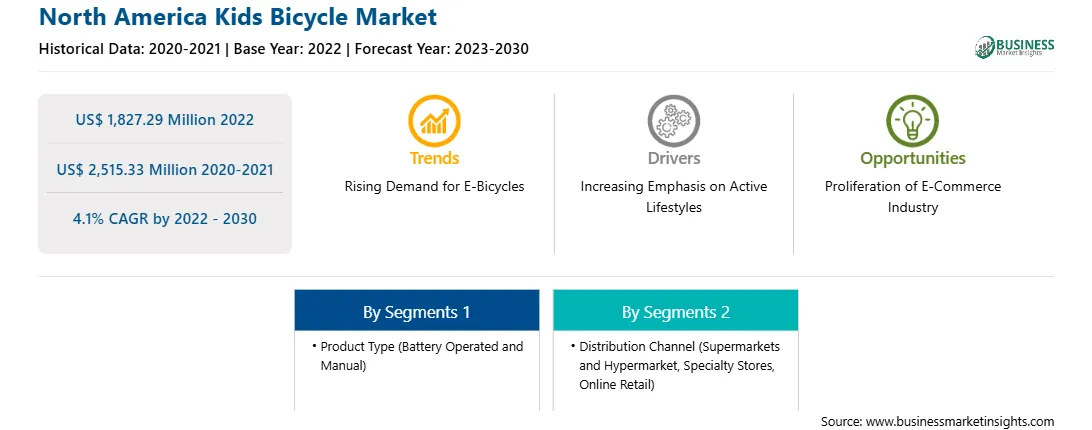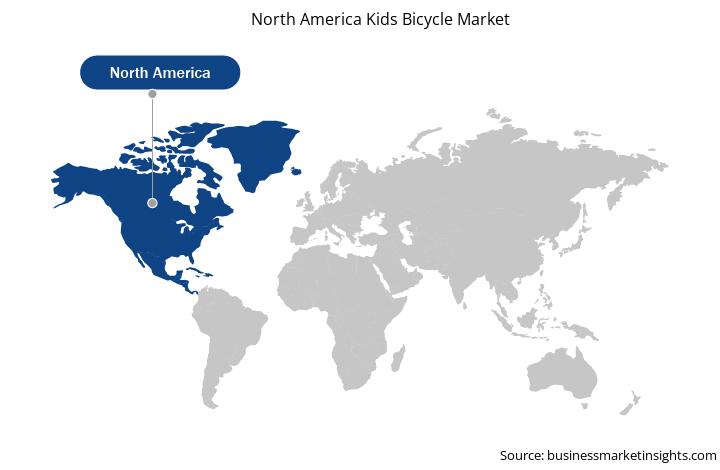The North America kids bicycle market was valued at US$ 1,827.29 million in 2022 and is expected to reach US$ 2,515.33 million by 2030; it is estimated to register a CAGR of 4.1% from 2022 to 2030. Increasing Emphasis on Active Lifestyles Fuels North America Kids Bicycle Market
The increased emphasis on promoting an active lifestyle for kids stands out as a pivotal driver propelling the growth of the kids bicycle market. In contemporary society, there is a growing awareness of the detrimental effects of sedentary lifestyles on children's health. Concerns about rising rates of childhood obesity and related health issues have prompted parents, educators, and health professionals to advocate for more physically active pursuits. According to the World Health Organization, 39 million children under the age of five were overweight or obese in 2020. Bicycling has emerged as a favored solution with its dual benefits of exercise and outdoor engagement. Parents, in particular, recognize the importance of instilling healthy habits early in a child's life. Riding bicycles provides an enjoyable form of physical activity and contributes to the overall well-being of kids. The emphasis on an active lifestyle aligns with a broader societal shift toward wellness and preventive health measures. As a result, bicycles for kids are not only seen as recreational items but as essential tools for fostering a healthy lifestyle from a young age. Educational institutions are crucial in driving this emphasis on an active lifestyle. Physical education programs increasingly incorporate cycling as a fundamental activity, promoting the development of motor skills, coordination, and cardiovascular fitness. This integration of cycling into educational curricula further cements the idea that bicycles are not just toys but integral components of a child's physical development. The digital age has also brought concerns about screen time and sedentary behaviors among children to the forefront. As a countermeasure, parents actively seek avenues to encourage kids to spend more time outdoors and engage in physical activities. Bicycling provides a perfect solution, allowing children to explore their surroundings, interact with peers, and experience the joy of movement. Therefore, the push for an active lifestyle has become a cultural and societal norm, significantly contributing to the robust demand for kids bicycles in the market.North America Kids Bicycle Market Overview
The region is witnessing increasing demand for kids bicycles owing to rising awareness of childhood obesity. A growing emphasis on promoting a healthy and active lifestyle for children is being driven by increasing awareness of childhood obesity and sedentary behavior. As parents and caretakers prioritize physical activity, the demand for bicycles as a means of exercise and outdoor recreation for children has risen. Cycling burns calories, promotes fitness, and builds muscle and coordination, making it a fun and effective tool for healthy development. The COVID-19 pandemic has also played a role in rising demand for kids bicycles. With lockdowns and restrictions limiting various outdoor sports and recreational activities, parents sought alternative ways to keep their children engaged and active. Bicycling emerged as a safe and enjoyable outdoor activity, where kids can enjoy and be active while maintaining social distancing, this factor contributed to the heightened demand for kids bicycles. For the past two decades, the Corvallis School District (CSD) in Oregon, US has encouraged students to walk and bike to school. All fifth-grade students participate in a weeklong bicycle safety class, which is expected to be soon expanded to include other grades. Under the Safe Routes to School (SRTS) programs, parents, schools, community leaders, and local, state, and federal governments are enabling and encouraging the walk and bicycling to schools to improve the health and well-being of children. Lighter frames, improved gears, and innovative safety features make kids bikes more enjoyable and user-friendly than ever before. Thus, manufacturers of kids bikes are constantly launching new products. For instance, in June 2023, Specialized, one of the largest cycling manufacturers, launched the Turbo Levo SL Kids hardtail electric mountain bike. The Specialized kids electric mountain bike has 24-inch wheels and is mainly designed to accommodate riders with height of 122 centimeters to 152 centimeters. Furthermore, the growing children population is also expected to drive the demand for kids bicycles. According to an estimate by the US Census Bureau, in the US, the population of children aged between 6-11 years was ~24.2 million in 2022 and is expected to grow to 26.0 million by 2030. The rising population of children propels the demand for kids bicycles in North America.
North America Kids Bicycle Market Revenue and Forecast to 2030 (US$ Million)
Strategic insights for the North America Kids Bicycle provides data-driven analysis of the industry landscape, including current trends, key players, and regional nuances. These insights offer actionable recommendations, enabling readers to differentiate themselves from competitors by identifying untapped segments or developing unique value propositions. Leveraging data analytics, these insights help industry players anticipate the market shifts, whether investors, manufacturers, or other stakeholders. A future-oriented perspective is essential, helping stakeholders anticipate market shifts and position themselves for long-term success in this dynamic region. Ultimately, effective strategic insights empower readers to make informed decisions that drive profitability and achieve their business objectives within the market. The geographic scope of the North America Kids Bicycle refers to the specific areas in which a business operates and competes. Understanding local distinctions, such as diverse consumer preferences (e.g., demand for specific plug types or battery backup durations), varying economic conditions, and regulatory environments, is crucial for tailoring strategies to specific markets. Businesses can expand their reach by identifying underserved areas or adapting their offerings to meet local demands. A clear market focus allows for more effective resource allocation, targeted marketing campaigns, and better positioning against local competitors, ultimately driving growth in those targeted areas.North America Kids Bicycle Strategic Insights

North America Kids Bicycle Report Scope
Report Attribute
Details
Market size in 2022
US$ 1,827.29 Million
Market Size by 2030
US$ 2,515.33 Million
Global CAGR (2022 - 2030)
4.1%
Historical Data
2020-2021
Forecast period
2023-2030
Segments Covered
By Product Type
By Distribution Channel
Regions and Countries Covered
North America
Market leaders and key company profiles
North America Kids Bicycle Regional Insights

North America Kids Bicycle Market Segmentation
The North America kids bicycle market is categorized into product type, distribution channel, and country.
Based on product type, the North America kids bicycle market is bifurcated into battery operated and manual. The manual segment held a larger market share in 2022.
In terms of distribution channel, the North America kids bicycle market is segmented into supermarkets and hypermarket, specialty stores, online retail, and others. The supermarkets and hypermarket segment held the largest market share in 2022.
By country, the North America kids bicycle market is segmented into the US, Canada, and Mexico. The US dominated the North America kids bicycle market share in 2022.
SCOTT Sports SA, Cycling Sports Group Inc, Merida Industry Co Ltd, BikeCo LLC, Kona Bicycles Co, Specialized Bicycle Components Inc, Trek Bicycle Corp, and Giant Manufacturing Co Ltd are some of the leading companies operating in the North America kids bicycle market.
1. SCOTT Sports SA
2. Cycling Sports Group Inc
3. Merida Industry Co Ltd
4. BikeCo LLC
5. Kona Bicycles Co
6. Specialized Bicycle Components Inc
7. Trek Bicycle Corp
8. Giant Manufacturing Co Ltd
The North America Kids Bicycle Market is valued at US$ 1,827.29 Million in 2022, it is projected to reach US$ 2,515.33 Million by 2030.
As per our report North America Kids Bicycle Market, the market size is valued at US$ 1,827.29 Million in 2022, projecting it to reach US$ 2,515.33 Million by 2030. This translates to a CAGR of approximately 4.1% during the forecast period.
The North America Kids Bicycle Market report typically cover these key segments-
The historic period, base year, and forecast period can vary slightly depending on the specific market research report. However, for the North America Kids Bicycle Market report:
The North America Kids Bicycle Market is populated by several key players, each contributing to its growth and innovation. Some of the major players include:
The North America Kids Bicycle Market report is valuable for diverse stakeholders, including:
Essentially, anyone involved in or considering involvement in the North America Kids Bicycle Market value chain can benefit from the information contained in a comprehensive market report.